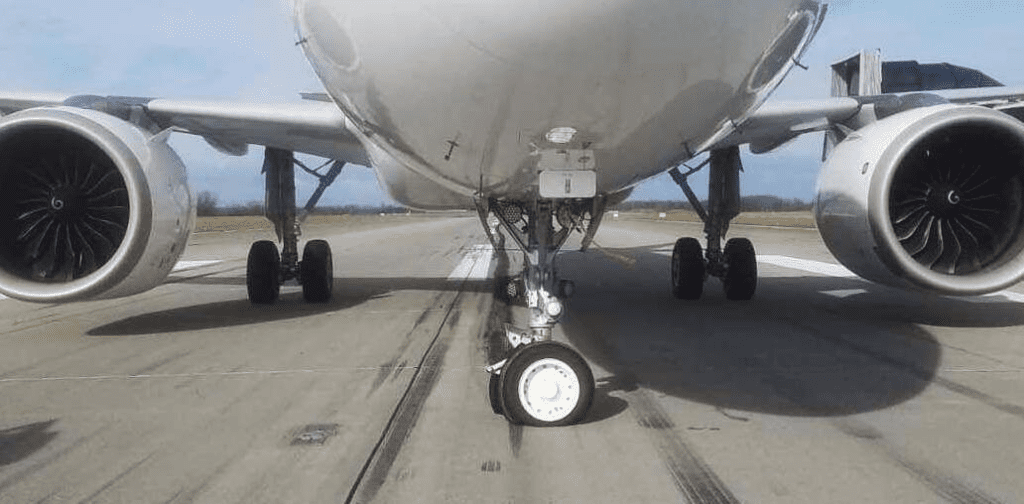
In the past few years, several events occurred involving landing with the Nose Landing Gear (NLG) wheels turned to 90° from the aircraft centerline.
The investigations identified the root causes, which were different for each event. Mitigating actions were developed and deployed accordingly.
This article describes the outcomes of investigations into several events of aircraft landing with NLG wheels at 90° and shows why they are not related. It also recalls the corrective actions and existing operational recommendations to prevent any recurrence.
CASE 1: NLG COMPONENT STRUCTURAL FAILURE

Event description
In 2005, during the takeoff of an A320 family aircraft, a few seconds after landing gear retraction was commanded, the L/G SHOCK ABSORBER FAULTECAM alert was triggered followed by the WHEELN/W STRG FAULT ECAM alert. As a result, the flight crew was not able to retract the Nose Landing Gear (NLG). They suspected an issue with the NLG, and so they performed a flyby allowing ATC to observe the situation of the NLG. ATC confirmed to the crew that the nosewheels of the aircraft were turned at 90°. The flight crew decided to divert to an airport with a longer runway. The aircraft remained airborne to use fuel before landing. The aircraft touched down on the runway and the flight crew delayed the nosewheel touchdown by not using ground spoilers, autobrake, or applying reverse thrust. The nosewheel tires burst shortly after touchdown and the wheels on the runway generated a lot of sparks. The aircraft remained on the runway centerline. After the aircraft stopped, the flight crew deemed that it was not necessary to perform an emergency evacuation and all passengers disembarked the aircraft using stairs.
Event analysis

There are two lugs on the upper support of the NLG shock absorber that prevent it from rotating freely in its housing (fig.1). The investigation showed that both lugs had sheared off and this caused the NLG to lose its centered position. This condition was immediately detected by the Landing Gear Control Interface Unit (LGCIU), which triggered the L/G SHOCK ABSORBER FAULT ECAM alert. The Braking & Steering Control Unit (BSCU) also detected the rotation and deactivated the Nose Wheel Steering (NWS) system. This triggered the WHEEL N/W STRG FAULT ECAM alert. The absence of nosewheel steering, combined with the broken anti-rotation lugs and the aerodynamic loads, enabled the NLG wheels to turn at 90° from the centerline.
It was discovered that the BSCU standard fitted to the aircraft at the time performed a greater number of steering movements during the preland checks compared to previous BSCU standards. This caused more fatigue to the 2 lugs on the upper support of the shock absorber. The internal pressure of the shock absorber was also found to be too high due to incorrect servicing during maintenance. This resulted in additional friction being applied to the NLG self-centering mechanical device, which is connected to the upper support, and eventually caused the 2 lugs to shear.
Prevention
New BSCU Standard
BSCU Standard L4.9B was developed with a reduced number of steering movements during the preland tests. The retrofit of this new standard is complete. The BSCU standard responsible for the lug failure is no longer in service.
The temporary solution published in OEB 175/176 is no longer applicable for any of the A320 family aircraft now that the BSCU retrofit campaign is complete.
Correct shock absorber servicing
Before this event, it was possible to perform servicing of the shock absorber with weight on wheels but it was difficult to service the correct pressure. This led to a tendency to overpressure the shock absorber and caused increased fatigue on its upper support. NLG shock absorber servicing procedures were improved following the event to allow for easier servicing with weight off wheels using jacks on the NLG. If the shock absorber can only be serviced with weight on wheels, then the servicing task must be done again, and with weight off wheels, within the next 7 days.
Source – Airbus




